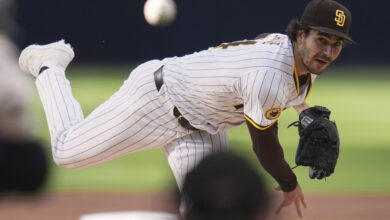
Curves Ahead: LHP Conor Lillis-White Could Be Legit Factor for Cubs
Little late to the party on this one, so I’ll try not to waste too much of your time here. The Cubs traded Tommy La Stella to the Angels in November for a player to be named later or cash, with lefty reliever Conor Lillis-White named Thursday as the return. A 26-year-old from Canada who attended the University of British Columbia, Lillis-White’s name can’t be found among the Angels’ top prospects lists.
He was, however, listed as one of the organization’s most underrated prospects in July of last year and could actually factor for the Cubs this season. I’m not going to be Pollyanna and try to convince you that this guy is going to develop into some sort of lock-down LOOGY, though I’ll say there’s potential for him to work out well if things break the right way.
Drafted in the 32nd round in 2015, Lillis-White was bothered by elbow issues early in his professional career and spent most of his first two seasons in rookie ball. The Angels must have seen something in the 6-foot-4, 220-pound lefty because they stuck with him when other other guys of his ilk might have been cut loose quickly. One of the things they saw was a guy averaging around 12.5 K/9 at those low levels.
The strikeouts continued as Lillis-White advanced, even improving at each new stop. He posted 10.88 K/9 at high-A to open the 2017 campaign, then maintained that mark across 44.2 innings at Double-A that same season. He put up 11.94 K/9 across 34.2 innings at Double-A to start 2018, increasing it to 12.54 in 37.1 Triple-A innings. As you might imagine, though, his walks have been somewhat of an issue (career 4.81 BB/9).
That doesn’t seem to fit the “pitch to contact” description of him in that link above, but the disparity comes from Lillis-White’s splits. He’s held lefties to a .188 average (.179 in Triple-A) and has struck them out at greater than a 30 percent clip. But while righties also accounted for 37 of his strikeouts (14.7 K/9) in 2018, they also hit .283 against him. Gosh, that feels a little Chatwood-y.
Lillis-White has a big curveball that he uses to buckle knees, so it may be a matter of dialing that in and working with his other pitches keep from getting behind in the count so often. Usage is another factor. He’s been used largely as a multi-inning reliever, always logging far more innings than appearances. Perhaps limiting the length of his outings and really focusing in on lefties would decrease the damage by righties who actually do make contact.
I’ve never seen him pitch, so I’m simply scouting the box score and some brief reports, but this guy does seem like Tyler Chatwood Lite. As damning as that is given last year’s debacle, it isn’t such a bad thing as long as Lillis-White can keep a few things under control. Walks are often a bugaboo with high-strikeout pitchers and there’s some belief that those guys are disproportionately harmed by minor league umpires who are flummoxed by serious movement, so some of that could be mitigated at the highest level of play.
But the real potential likely comes from improving — or flat-out eliminating — the whole three-outcome deal with righties. They either strike out, walk, or get a hit, with outs via contact not coming nearly as frequently as you’d like to see. If the Cubs believe Lillis-White can do that consistently, the attention really shifts more to lefty reliever Brian Duensing, one of the contracts the team would surely like to move this winter.
And who knows, maybe this ends up as one of those deals no one even remembers come April. There’s at least an outside chance, however, that Lillis-White could give the Cubs a little something in the future.

